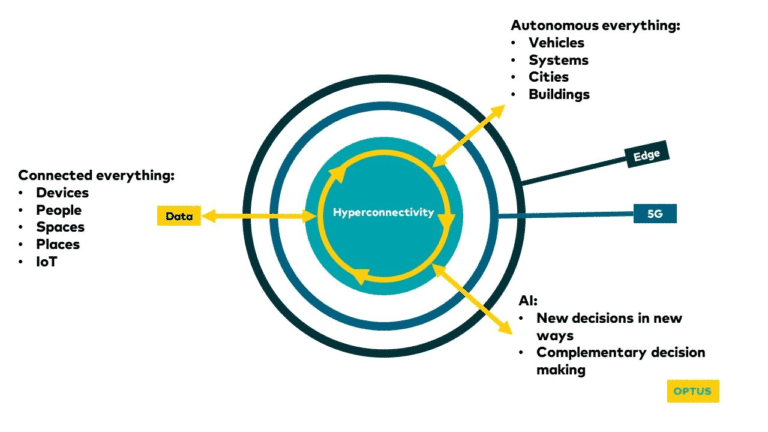In today’s rapidly evolving technological landscape, we find ourselves immersed in a hyper-connected, intelligent world.
The advent of the Internet and subsequent advancements in artificial intelligence (AI) and the Internet of Things (IoT) have ushered in an era where our devices, homes, cities, and industries are interlinked and infused with unprecedented intelligence.
This interconnectedness has the potential to revolutionize how we live, work, and interact with our environment while addressing pressing global challenges.
In this article, we will explore the multifaceted aspects of this hyper-connected, intelligent world, its implications, and how it is shaping our future.

Connecting the Dots: The IoT Revolution
The backbone of this hyper-connected world is the Internet of Things (IoT), a network of physical objects embedded with sensors, software, and other technologies to collect and exchange data.
These objects, ranging from everyday appliances to industrial machinery, communicate seamlessly with each other, feeding vast amounts of data into AI systems.
This data becomes the lifeblood of intelligent decision-making, enabling us to optimize resource usage, enhance efficiency, and create smarter, more sustainable solutions.
AI: The Brain Behind It All
At the heart of this hyper-connected world lies artificial intelligence. AI processes the torrents of data generated by IoT devices, transforming raw information into actionable insights.
Machine learning algorithms, a subset of AI, play a crucial role in this process. These algorithms continuously analyze data patterns, adapt to changing conditions, and make predictions, allowing systems to become more intelligent over time.
For instance, in agriculture, Artificial Intelligence-powered systems can monitor soil conditions, weather patterns, and crop health in real-time.
This data-driven approach empowers farmers to make informed decisions, optimizing irrigation, fertilization, and pest control. Consequently, crop yields increase, while resource wastage diminishes, contributing to sustainable agriculture practices.
Enhancing Everyday Life
The impact of this hyper-connected, intelligent world extends to our daily lives. Consider the smart home, where IoT devices and AI-driven automation collaborate to enhance convenience, security, and energy efficiency.
Smart thermostats learn our temperature preferences, adjusting heating and cooling accordingly, which not only saves energy but also lowers utility bills.
Home security systems equipped with facial recognition and motion sensors provide a sense of safety, while smart appliances like refrigerators can notify us when groceries run low.
Urban Transformation: Smart Cities
Beyond our homes, entire cities are undergoing transformation into smart cities. IoT sensors monitor traffic flow, reducing congestion and air pollution.
Smart waste management systems optimize garbage collection routes, minimizing fuel consumption and emissions. Streetlights equipped with motion sensors illuminate pathways only when needed, conserving energy.
Moreover, smart city infrastructure enables better disaster management and response, safeguarding citizens during emergencies.
Sustainable Energy Solutions
One of the most promising aspects of this hyper-connected world is its potential to address environmental challenges, particularly in the realm of sustainable energy.
Smart grids, for instance, use IoT and AI to balance the supply and demand of electricity more efficiently. They integrate renewable energy sources like solar and wind power seamlessly, reducing reliance on fossil fuels and lowering carbon emissions.
AI also plays a pivotal role in predictive maintenance for renewable energy infrastructure. By analyzing data from wind turbines and solar panels, AI algorithms can detect potential issues before they lead to costly breakdowns.
This proactive approach ensures that renewable energy sources operate at peak efficiency, maximizing their contribution to clean energy generation.
Healthcare Revolution
In healthcare, the hyper-connected, intelligent world is saving lives and improving patient care. Wearable devices equipped with sensors continuously monitor vital signs, transmitting real-time data to healthcare providers.
AI algorithms analyze this data, alerting medical professionals to any anomalies. This early detection can prevent medical crises and lead to more effective treatments.
Moreover, AI-driven drug discovery is accelerating the development of new medicines. Machine learning models analyze vast datasets of chemical compounds.
And their effects on diseases, significantly shortening the time it takes to bring new drugs to market. This not only benefits patients but also reduces the cost of drug development.
Challenges and Concerns
While the hyper-connected, intelligent world offers immense potential, it also presents challenges and concerns. Privacy and security are paramount issues.
With the proliferation of IoT devices collecting personal data, safeguarding this information from cyber threats is crucial. Striking the right balance between convenience and privacy remains a complex task.
Another concern is the digital divide. Not everyone has equal access to this hyper-connected world, leading to potential inequalities in education, employment, and healthcare.
Bridging this gap is essential to ensure that the benefits of technology are distributed equitably.
The Road Ahead: Regulations and Ethical Considerations
As we navigate this hyper-connected, intelligent world, regulations and ethical considerations become increasingly important. Governments and organizations must establish robust data protection laws to safeguard individual privacy.
Additionally, ethical guidelines for AI development and use are essential to ensure fairness, transparency, and accountability.
The ethical use of AI also extends to decision-making algorithms. These algorithms must be designed to avoid biases and discrimination, particularly in areas like hiring, lending, and criminal justice.
Ensuring that AI benefits society as a whole requires a proactive approach to ethical AI development.
Conclusion: A Brighter Future
In this hyper-connected, intelligent world, our lives are becoming more efficient, sustainable, and interconnected.
The fusion of AI and IoT is reshaping industries, enhancing everyday experiences, and addressing global challenges. However, as we embrace this future, it is crucial to remain vigilant about privacy, security, and ethics.
With the right regulations and ethical frameworks in place, we can harness the full potential of the hyper-connected, intelligent world, paving the way for a brighter and more sustainable future for all.
